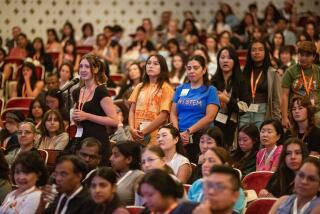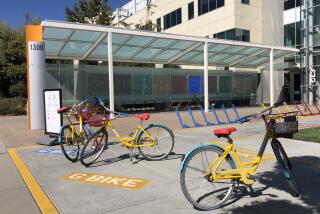Math Push Adds Up for Chief of Science Foundation
Rita Colwell, director of the National Science Foundation, has spent her life studying the cholera bacterium and its relationship to the environment. She has presided over an unprecedented explosion in the biological sciences--including, most recently, the sequencing and first glimmerings of understanding of the human genome. Yet Colwell has set a new priority for the NSF, and itâs not life sciences, but mathematics. Recently she spent an afternoon chatting with Times science writer K.C. Cole about a biologistâs love of math, passion for science, and the serious pursuit of joy.
Question: So whyâs a biologist making such a big push for a mathematics initiative?
Answer: I think itâs caught the mathematicians by surprise. After all, itâs a wonderful time for biology. But the investment that has been made in math has been surprisingly small. Our grants in mathematics are smaller than those in other sciences. Since 1992, the number of students getting bachelorâs degrees in mathematics has dropped by about 23%. And mathematics is so fundamental to all of science. I have lived through the transformation of biology. Itâs gone from a descriptive science to a highly quantitative one. Even the social and behavioral sciences are ready to explode with huge databases. We need to develop new mathematical thinking to make use of that wealth of information.
*
Q: For example?
A: Protocols in research have gotten enormously complicated. In my own research with cholera, we instituted a very simple water filtration technique to assist families where there is not water treatment to prevent spread of the disease. We see some successes already. The question is: At what point do you stop the experiment and implement it? That is a very complicated statistical question. If you stop too soon, you may not have the data you need. If you stop too late, people may die.
*
Q: So what is the role of mathematics?
A: Mathematics reduces complex problems to the fundamentals. Itâs clean. Itâs concise. It reduces the bulk of information that is very hard to load up in your arms. You can express complicated situations in a way thatâs clearly understood, and allows you to make predictions. If we want to build a highway, and we have all the data of the weather patterns for the past 100 years, and we know the demographic patterns, vegetation and watershed data, and so forth, all that can go into a computer. Then we can build mathematical models and make predictions: If you build a highway there, you will have these kinds of possible effects, and if you put it in an alternative site youâll have these other effects. Then you can make a rational, science-based decision.
What is really being said in an equation is simple. But it seems foreign because the letters are Greek and the symbols are squiggles. But if those squiggles were as familiar as your roller blades, you wouldnât think about the foreignness of it; you could concentrate on analyzing what it was saying.
*
Q: But isnât all the mathematics that you need to solve these kinds of problems already out there?
A: Not at all. It will require new mathematical research. Before mathematical concepts can be applied, they must be invented. This is not going to be achieved by simply linking together the computers weâve got. Weâre moving into entirely new approaches, computers for the future, like quantum computing and DNA-based computing.
But we havenât talked about beauty. Mathematics is so soul-satisfying. Thereâs such enormous beauty in mathematics, and scientists have almost been embarrassed by the fact that the work they do is beautiful. At the end of a really good lecture--in math or molecular biology--your reaction often is: That was beautiful. And it really is.
So instead of having a fight over pornography and art, why arenât we focusing on the beauty of how the world works? The formations of geese flying overhead in the sky, the patterns in the tiniest nanostructures. Have you ever noticed when you add liquid detergent to the washing machine how it goes into the water in a big swirl . . . following the laws of physics?
When I was a graduate student, I donât think itâs overly dramatic to say that we worshiped at the altar of science. Science was a way to understand ourselves and why weâre here, to provide some kind of control in our lives and an understanding of our universe. Now, somehow something has gone askew. It really has. Some of the joy of being seems to have vaporized.
*
Q: Why do you think that is?
A: I get a sense itâs because people are job driven rather than life driven. Students come to me and ask, should I go into this or that area of science because the jobs are plentiful there now? My answer is: Do what you love. Do what you have a passion for. Because it doesnât matter whether there are jobs now or whenever, because if youâre good at it, if you love what you are doing, then there will be a job for you.
But the pressures are enormous. NSF is the only agency with the mission of basic research and science and math education. We receive 30,000 proposals every year. And 16% of the proposals that are judged excellent or very good canât be funded because of the lack of funds. And it often takes a young investigator three tries to get funded. It is costly in time and money and a loss in potential advances in science and engineering.
The result is that a young scientist is like women a hundred years ago in China, hobbling along with bound feet, instead of making grand strides.
If we could increase the award size of proposals we fund and extend the length of time of each proposal it would allow students to spend their early years in the laboratory instead of being chained to a PC, writing proposals. It would also be more efficient. If it takes 120 hours to write a proposal, at say, $50 an hour, you add it up. Itâs costing people a lot.
*
Q: But doesnât the problem with mathematics start much earlier--in grade school?
A: We do know that the âvalley of deathâ is between fourth and eighth grade, for both math and science. For both boys and girls, but especially for girls. NSF is currently able to spend only $270 million a year on K-12 science and mathematics education, and clearly that is not enough.
Weâve been hoping, dreaming, of a plan to start centers for the science of learning, that would focus on education in science and math with as much intensity as we now put into other areas of research in science and engineering.
I strike the analogy, which I donât think is farfetched, as follows: Transportation in 1900 was by horse and buggy. In 2000, we have spacecraft. In medicine, if you had diabetes at the turn of the century, you were treated palliatively, and you probably died at an early age. Now weâre able to extract cells from the pancreas, grow them in culture, correct the genetic error, and return the cells to the diabetic individual, with the possibility of cure for the diabetes.
Now look at education. In 1900, we had books, teachers, classroom, blackboard, desks. In 2000, we have books, teachers, classrooms, blackboards, desks. A lot has happened in understanding how humans think, in the cognitive and behavioral sciences. . . . Why hasnât all this new knowledge infused education the same as it has for transportation and medicine?
*
Q: We seem to be moving in the opposite direction. The Wall Street Journal reported that science funding will be reduced drastically to pay for a tax cut. Yet, last year the number of PhDs awarded in the U.S. declined for the first time since 1985--most dramatically in engineering and science.
A: A bipartisan commission--the United States Commission on National Security/ 21st Century--recently concluded . . . that a greater threat to U.S. national security, more than any potential conventional war . . . would be the decline and loss of vitality and strength in science and engineering research and education in the U.S. And I agree.
*
Cole can be reached at [email protected]






